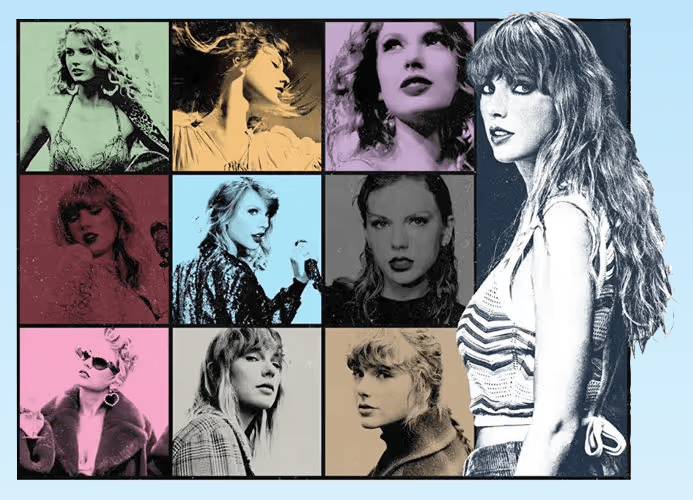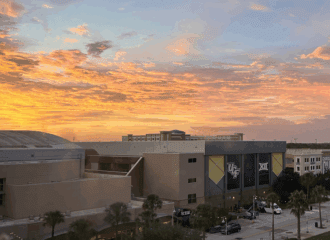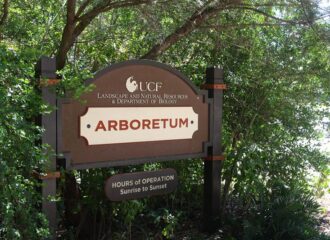by Emma Drauer
In Spring 2024, I took my favorite class of my undergraduate career: Rhetoric in Pop Culture (Taylor’s Version). Rhetoric in Pop Culture is a unique course in that it focuses on a different theme each semester. I took the course when the theme was Taylor Swift; the semester before, it was fantasy football, and before that, podcasting. While this class is offered by the Department of Writing and Rhetoric, it is not a restricted elective and is open to students from all majors. Furthermore, you can take it twice for credit if there’s another subject that interests you.
If you aren’t familiar with the word or concept of rhetoric, it refers to the manipulation of language for an intended purpose, usually persuasion. A common example is how politicians use rhetoric to either gain your trust or get you to distrust an opponent or opposing organization. While it is most commonly seen in the written form, rhetoric also exists auditorily and visually. Auditorily, rhetoric can be found in oral deliveries such as speeches and music. Visually, rhetoric can be found in the symbols and images of things like posters and videos. In Rhetoric in Pop Culture, we analyzed the rhetoric used in specific discourse communities, or groups of people with shared interests and goals, such as Swifties. Beyond that, we used discussions about Taylor Swift to examine the rhetoric used by the general public on social media, as well as the rhetoric used by scholars, journalists, and critics. We also focused on how Taylor Swift herself uses rhetoric in her communications.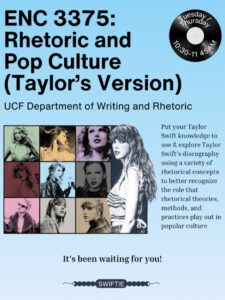
While a majority of our class discussions centered on Swift and the rhetoric surrounding her, we also engaged in conversations about other artists such as Travis Scott. So, while each semester follows a theme, you are not restricted to it.
Unlike most college courses, Rhetoric in Pop Culture provides a chance to engage with popular culture within an academic context. There is a lot that we can learn from studying pop culture. For example, one major theme we discussed was the idea of parasocial relationships, or imagined relationships between a fan and a celebrity: “These relationships are one-sided, where one person invests time, emotions, and possibly money into the other person, while the other party is unaware of their existence,” according to a 2022 article from Simply Neuroscience. I admit that I have a parasocial relationship with Swift among many other celebrities. Having conversations about this kind of celebrity-fan relationship enabled further reflection on my online activity and encouraged me to think more deeply about my “real” relationships, providing a much-needed reality check that I think a lot of Gen Z could benefit from.
Our first major project was an analysis of the visual rhetoric of one of Taylor Swift’s live performances or music videos. I analyzed The Eras Tour performance of Taylor Swift’s song “My Tears Ricochet.” I wrote about how Swift used background visuals and staging (which includes elements like costumes, choreography, and camera angles) to create the scene of a funeral, where she mourns a metaphorical death caused by the pain of betrayal. Her performance is purposely drowned in emotion, enabling the audience to connect with the pain of the betrayal she’s experiencing. This assignment benefited me in multiple ways. By practicing looking at visual cues to identify an author’s intent, I gained skills that I can apply to deciphering the messages of commercial advertisements and political propaganda. As a communicator myself, this knowledge also helps me decide when to include specific visuals to appeal to my target audience, which has been immensely useful when creating multimodal persuasive documents. These few examples demonstrate how an understanding of rhetoric can be an advantage in marketing, public relations, and political spheres, but it is important to keep in mind that learning about rhetoric is beneficial to everyone.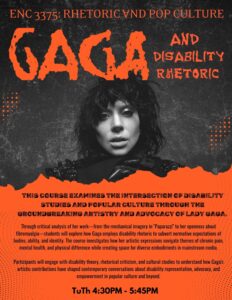
Taking Rhetoric in Pop Culture taught me valuable skills applicable to any career field through fun, interesting topics. Further, it allowed me to discuss pop culture within an academic setting unlike any course I had ever taken before. I gained so much from this course, and you can, too. The theme for this upcoming Fall semester is Gaga & Disability Rhetoric, and if it weren’t for me graduating this May, I would already be enrolled. Regardless of your major, Rhetoric in Pop Culture is a great opportunity, and I highly recommend signing up for this class.

